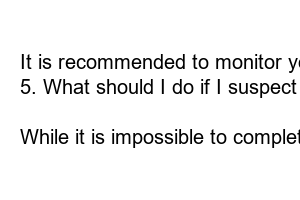개인 정보 유출 확인
Confirm Personal Information Leakage: How to Protect Your Data
In our interconnected digital world, personal information leakage has become a pressing concern for individuals and businesses alike. From data breaches to online scams, the risks of having our personal information exposed are ever-present. Therefore, it is essential to be proactive in safeguarding our sensitive data by confirming its security. In this blog post, we will explore the steps you can take to confirm personal information leakage and protect your data.
1. Understand the Risks of Personal Information Leakage
With the increasing dependence on technology, it’s important to understand the risks associated with personal information leakage. Identity theft, financial fraud, and reputational damage are just a few of the potential consequences. By acknowledging these risks, you can better appreciate the necessity of confirming the security of your personal information.
2. Monitor Your Accounts Regularly
One effective way to detect any potential personal information leakage is by regularly monitoring your accounts. Keep a close eye on bank statements, credit reports, and online profiles to identify any unauthorized activity. By doing so, you can quickly respond and take appropriate action if any suspicious transactions or changes are detected.
3. Use Strong and Unique Passwords
Weak or reused passwords are a common vulnerability that can lead to personal information leakage. Ensure that your online accounts are protected with strong and unique passwords, consisting of a combination of uppercase and lowercase letters, numbers, and special characters. Password managers can help you generate and securely store passwords for each account you use.
4. Enable Two-Factor Authentication
Adding an extra layer of security to your online accounts is essential. By enabling two-factor authentication, you ensure that even if your password gets compromised, a secondary verification step is required for access. This can include a verification code sent to your mobile device, a fingerprint scan, or a security token.
5. Be Cautious of Phishing Attempts
Phishing attempts, where cybercriminals pose as legitimate entities to deceive individuals into revealing their personal information, are on the rise. Be cautious of emails, messages, or phone calls requesting sensitive information or urging immediate action. **Verify the legitimacy of the source** before providing any details.
6. Regularly Update and Secure Your Devices
Regularly updating your devices, operating systems, and applications is crucial to ensure that security vulnerabilities are patched. Additionally, use reputable antivirus software and enable firewalls to protect against malware and unauthorized access. By taking these steps, you can significantly reduce the risk of personal information leakage.
Summary:
In today’s digital age, confirming personal information leakage is an essential step towards protecting your sensitive data. By understanding the risks, actively monitoring your accounts, using strong passwords, enabling two-factor authentication, being cautious of phishing attempts, and regularly updating and securing your devices, you can mitigate the risks associated with personal information leakage. Stay vigilant and proactive in safeguarding your personal information to ensure your privacy and security online.
FAQs
1. What is personal information leakage?
Personal information leakage refers to the unauthorized disclosure or exposure of sensitive personal data, which can lead to various risks such as identity theft and financial fraud.
2. How can I confirm personal information leakage?
You can confirm personal information leakage by regularly monitoring your accounts, using strong and unique passwords, enabling two-factor authentication, being cautious of phishing attempts, and updating and securing your devices.
3. What are the risks of personal information leakage?
The risks of personal information leakage include identity theft, financial fraud, reputational damage, and potential loss of privacy.
4. How often should I monitor my accounts for personal information leakage?
It is recommended to monitor your accounts regularly, ideally on a monthly basis, to swiftly detect any unauthorized activity or changes.
5. What should I do if I suspect personal information leakage?
If you suspect personal information leakage, you should immediately notify the relevant authorities, such as your bank or credit card issuer, and take appropriate steps to secure your accounts and personal information.
6. Can personal information leakage be prevented entirely?
While it is impossible to completely eliminate the risk of personal information leakage, you can take proactive measures, such as following the guidelines mentioned above, to minimize the risks and protect your data.

